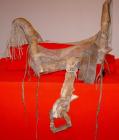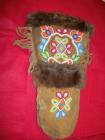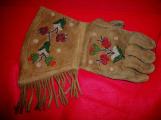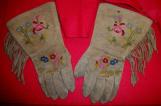1
Intertribal Trade: Items from the Neighbors and Enemies of the BlackfootThe Blackfoot peoples - the Blood, Piegan and Blackfoot proper - had a long history of interaction with First Nations peoples from all directions.
These contacts included
- The Kootenay, Flathead, Shoshoni and Nez Perce of the mountains,
- The Cree, Assiniboine, Saulteaux and Ojibwa of the eastern plains,
- The Crow, Gros Ventres, Mandan, Cheyenne and Sioux of the American plains.
The possibilities of further contact with other First Nations was infinite as hunting presures, colonial politics, trade connections and territorial encroachments progressed through the 17th, 18th and 19th centuries. One example is that of the voyageurs from Quebec, working for the trade combines of the Hudson's Bay Company and North-West Company. Many of these voyageurs were of Iroquois descent, from the forests of Quebec. Other traders and labourers of French, Scots and English employers intermingled with prairie and woodland First Nations to give rise to the mixed-blood or Metis people.
Through contact, the Blackfoot kept their culture vibrant by acquiring items previously unknown to them, and adapting their uses.
Most significant of these items was the adoption of the horse in the late 18th century, and the simultaneous acquisition of the firearm. The use of both items made the Plains First Nations more mobile, and more prolific in the hunting of game, primarily the buffalo
Inter-tribal contact was both friendly and war-like, with acquisitions made both by trade and as captured property in conflict.
When and where the Blackfoot first began to acquire items of European derivation cannot be pinpointed, but some reasonably accurate assumptions can be made that such items were first seen in the late 1600s with the establishment of the Hudson's Bay Company. Though located far from their territory, the Cree acted as "middle-men," bringing the trade into the prairies in exchange for buffalo robes.
HBC employee Anthony Henday is the first known European to meet the Blackfoot, on the North Saskatchewan River in 1754. Peter Fidler made the first foray into the upper Belly River in 1792, and finally trade competition brought the HBC and NWC further inland until the establishment of Fort Edmonton in 1795. Through further visits by traders and explorers into what is now southern Alberta, the Blackfoot were encouraged to trade at Edmonton. But an incident with the American Lewis and Clark expedition caused the Blackfoot to close their realm to all Euro-American intrusion for decades. In the 1830s, representatives of the American Fur Company reintroduced trade on the Missouri River of what is now Montana. For some forty years, the Blackfoot brought their business to either the HBC in the north or the AFC or the south, depending on their travel patterns. But for the most part, their fearsome reputation kept permanent settlement out of the river basins of the upper South Saskatchewan Rivers.
All of that changed with the establishment of Fort Whoop-Up in 1869, by independent Montana traders John J. Healy and Alfred Hamilton. With trade settlements, first by the Montanans, and secondly, by the Canadian government establishment, the sovereignty of the Blackfoot Confederacy in southern Alberta was all but ended.
Through the years of trade, the dynamics of the First Nations of the prairies changed significantly, as did territorial boundaries. The Cree traders became a plains tribe in competition with the Blackfoot, and formed alliances with the Metis, Saulteaux and Ojibwa nations. War pressures among the bands, and from encroaching white civilizations changed trade dynamics significantly.
2
Beaded Buffalo Hide Saddle Blanket - "Immoyitaan"Circa 1930s
Fort Whoop-Up National Historic Site
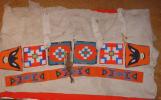 Credits:
Credits:Gord Tolton
3
Beaded Buffalo Hide Saddle Blanket - "Immoyitaan"Circa 1930
Fort Whoop-Up National Historic Site
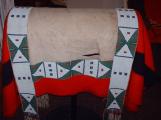 Credits:
Credits:Gord Tolton
6
Shawl Neckline Pieces - "Isttohksaan"Circa 1880s
Fort Whoop-Up National Historic Site
 Credits:
Credits:Quinn Pereverseff
7
Hudson's Bay Company Bag - "Skinittsimaan" (bag) "Akaisatstsaa" (HBC blanket)Circa 1930s
Fort Whoop-Up National Historic Site
 Credits:
Credits:Quinn Pereverseff
11
Cheyenne Head Dress/War Bonnet (Saaami) - "Ayayiisoonii'p" or "Ayiisoyiisaaam"1830
Fort Whoop-Up National Historic Site
 Credits:
Credits:Gord Tolton
12
Flathead Head Dress - "Okamiipoohsaam" or "Mokamiipoohsaami"1870
Fort Whoop-Up National Historic Site
 Credits:
Credits:Gord Tolton

